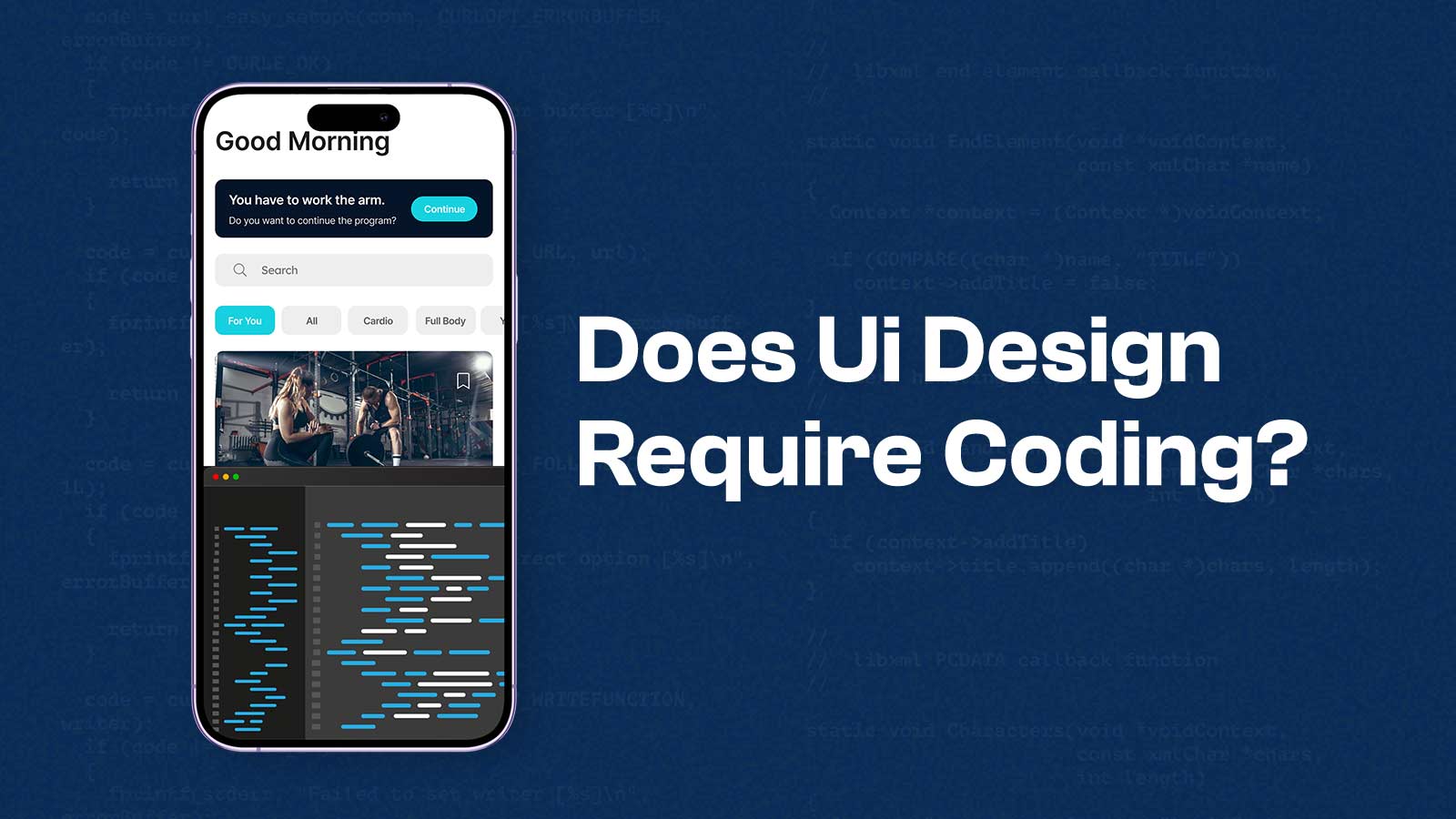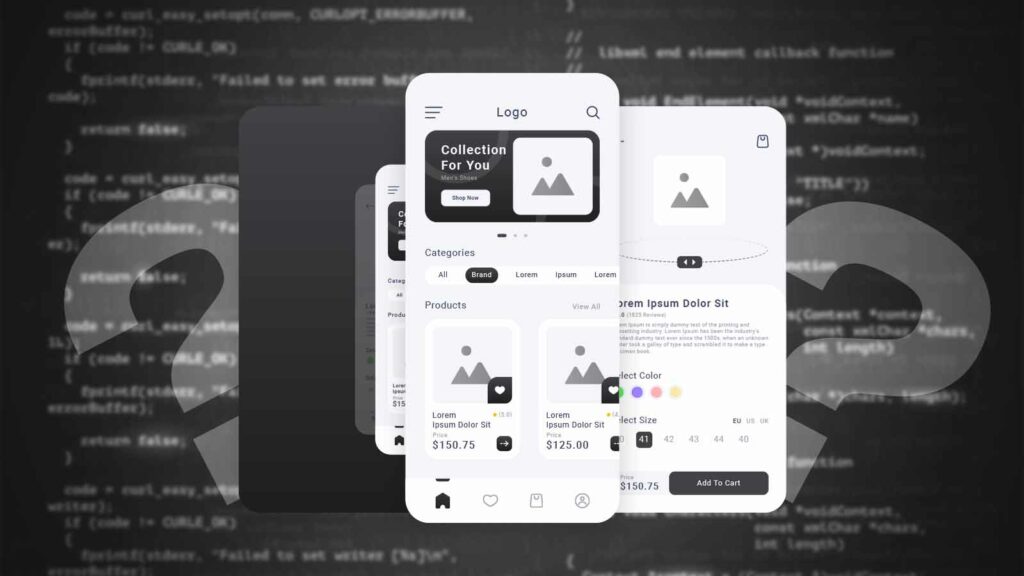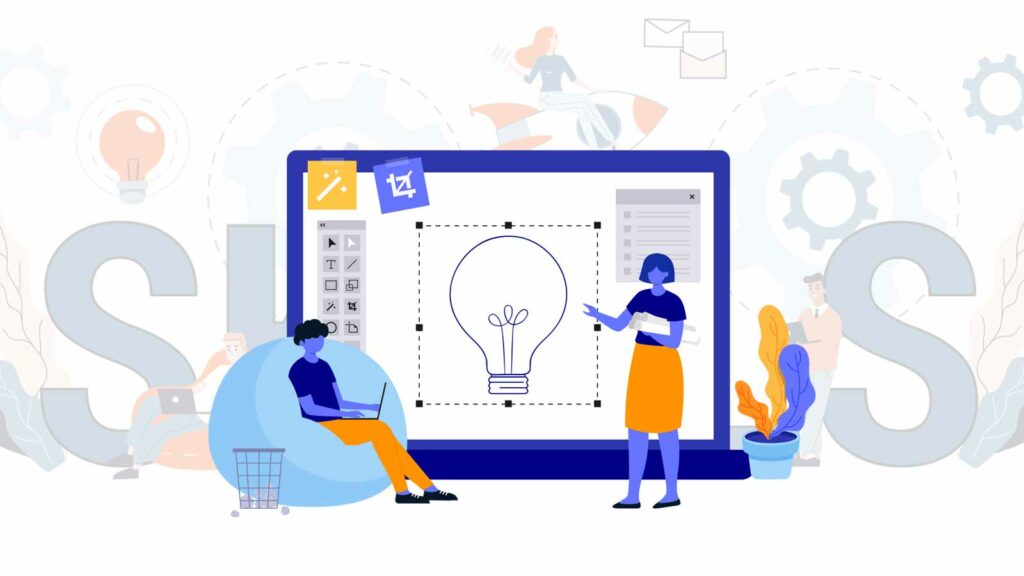
Does UI Design Require Coding? Or Can You Do Without It?
The relationship between UI (User Interface) design and coding is a topic that often stirs debate and curiosity. As the digital landscape continues to evolve, many aspiring UI designers wonder does UI design require coding or if they can thrive without it.
UI design doesn’t inherently require coding, but it’s increasingly valuable. While UI designers can thrive without coding, basic knowledge enhances their skills, communication with developers, and understanding of technical constraints. It’s a bridge that can elevate their design and collaboration capabilities.
In this blog post, we explore the nuances of this question and shed light on the role of coding in UI design.
Does UI Design Require Coding?

UI design does not inherently require coding, but having coding skills is increasingly desirable. In the tech and design industry, product development and UI design are often interconnected. Understanding both design and development is becoming more crucial. Front-end and back-end designers benefit from comprehending each other’s constraints and needs when it comes to design.
While UI designers can create visually appealing and user-friendly interfaces, having coding skills can enhance their ability to collaborate effectively with developers, bridging the gap between design and implementation. This synergy between design and coding ensures a smoother and more efficient product development process, making coding knowledge a valuable asset in the UI design field.
Coding 101 for User Interface Designers

For User Interface (UI) Designers, understanding the basics of coding, specifically HTML and CSS, can be a game-changer. Learning to write front-end UI code and preview it on different devices provides immediate feedback on design choices. HTML and CSS use pixels as the default unit of measurement, although other units like “ems” and percentages can be converted to pixels.
By delving into coding, UI designers gain an appreciation for the front-end development process. This knowledge equips them with insights into metrics and code structure, helping them optimize their designs for practicality and feasibility.
Designers will discern what’s easy to implement and what requires more effort, fostering a more collaborative and efficient design process. Coding 101 for UI designers is not about becoming developers but about gaining a deeper understanding of the technical aspects of design, resulting in more effective and user-friendly interfaces.
Why Coding Is a Valuable Asset for UI Designers?

Coding is a valuable asset for UI designers for several reasons:
- Effective Collaboration: UI designers who understand coding can communicate more effectively with developers. They can bridge the gap between design and implementation, ensuring that their creative vision is accurately translated into the final product.
- Practical Design Implementation: Knowing how to code allows UI designers to create designs that are not only visually appealing but also practical and feasible to implement. This helps avoid unrealistic or overly complex design concepts.
- Problem Solving: Coding skills enable UI designers to troubleshoot and solve design-related issues more independently. They can identify and address design constraints and technical limitations, leading to better and more user-friendly designs.
- Efficiency: UI designers who can code can create prototypes and interactive mock-ups, which can be extremely helpful for testing and refining designs. This speeds up the design iteration process and ultimately results in better user experiences.
- Adaptability: In the ever-evolving tech industry, having coding skills allows UI designers to adapt to new design tools and trends more quickly. They can experiment with and understand the latest technologies, staying relevant in the field.
- Career Advancement: UI designers with coding skills are often in higher demand and may have access to a wider range of job opportunities. They can take on more versatile roles that encompass both design and development aspects.
Do I Need To Know Programming To Be A UI Designer?

No, you do not necessarily need to be a proficient programmer to become a UI (User Interface) designer, but having some level of programming knowledge can be advantageous and broaden your career prospects. Here’s a more detailed explanation:
1. Core UI Design Skills: At its core, UI design primarily involves creating visually appealing and user-friendly interfaces. Proficiency in graphic design, layout principles, typography, color theory, and user experience design is essential. These skills are the foundation of UI design.
2. Design Tools: UI designers commonly use design tools such as Adobe XD, Sketch, Figma, or Adobe Photoshop to create mock-ups, wireframes, and prototypes. Mastering these tools is a key aspect of the role.
3. Understanding User Behavior: A deep understanding of user behavior and psychology is crucial. UI designers need to create interfaces that resonate with the intended audience, are easy to navigate, and provide a seamless user experience.
4. Collaboration: UI designers work closely with other professionals, including UI designers, front-end developers, and product managers. Effective collaboration and communication skills are vital to translating design concepts into functional products.
5. Coding as a Bonus: While coding is not mandatory, knowing HTML, CSS, and JavaScript can be beneficial. It allows UI designers to understand the technical aspects of implementation better and collaborate effectively with developers. You can create interactive prototypes, understand the limitations of web or app development, and make design decisions that align with the technical requirements.
6. Specialization: Some UI designers choose to specialize in front-end development as well, becoming “UI developers.” They have the skills to both design and implement the user interface. This dual expertise can be particularly valuable in smaller teams or when working on personal projects.
Which Programming Languages Do UI Designers Choose?

UI designers, while not primarily programmers, often find it beneficial to have a foundational understanding of coding languages to facilitate communication with developers and enhance their design capabilities. Here are the programming languages that UI designers commonly choose to learn:
1. HTML (HyperText Markup Language):
HTML is the fundamental language for building web pages. It provides the structure of a webpage, defining elements such as paragraphs, headings, links, images, and more. For UI designers, understanding HTML is crucial as it helps in creating design mock-ups that align with the actual page structure. It ensures that the visual design is practical and feasible for implementation.
2. CSS (Cascading Style Sheets):
CSS is another essential language used in web design. It is used to control the presentation and formatting of web content, including elements like font size, color, layout, and positioning. UI designers often use CSS to add styling and formatting to their designs. Knowing CSS allows designers to create visually appealing and consistent interfaces.
3. JavaScript:
While not as critical as HTML and CSS for UI designers, JavaScript can be a valuable addition to their skill set. JavaScript is widely used to add interactivity and dynamic behavior to web pages. UI designers who know JavaScript can create interactive prototypes, enhance user experiences, and better understand the technical possibilities and limitations of web development. This knowledge can also facilitate collaboration with front-end developers.
Advantages of Learning HTML and CSS:
All UI designers can benefit from learning HTML and CSS, even if they intend to become something other than full-fledged programmers. Understanding these languages fosters a shared understanding with developers, making collaboration more effective. Designers gain insights into how their designs will be implemented and can ensure that their concepts align with technical feasibility.
Advantages of Learning JavaScript:
Knowledge of JavaScript can be advantageous for UI designers who want to add interactivity to their prototypes and better collaborate with developers. JavaScript enables the creation of dynamic and responsive elements, making it a valuable asset for enhancing the user experience. It also allows designers to showcase front-end and back-end interactions in real-time without needing to restart the website or application.
Essential Skills Of A UI Designer

UI (User Interface) designers play a pivotal role in creating digital interfaces that are not only aesthetically pleasing but also intuitive and user-friendly. To excel in this field, UI designers need a diverse skill set. Here are eight essential skills for a UI designer:
1. Visual Design: Visual design is at the heart of UI design. UI designers must have a keen eye for aesthetics, including a strong understanding of color theory, typography, layout, and graphic design principles. They create visually engaging and harmonious interfaces that capture the user’s attention and convey the intended message.
2. User-Centered Design: A deep understanding of user behavior and psychology is essential. UI designers should be able to empathize with users, conduct user research, and create designs that align with user needs and expectations. The goal is to provide an exceptional user experience.
3. Prototyping and Wireframing: UI designers use wireframing and prototyping tools to create low-fidelity and high-fidelity mock-ups of interfaces. These tools help in visualizing and testing the design concepts, allowing for quick iterations and improvements based on feedback.
4. Interaction Design: Interaction design focuses on how users interact with an interface. UI designers need to design intuitive navigation, interactive elements, animations, and transitions. They ensure that users can easily navigate through the interface and perform tasks without confusion.
5. UI Design Tools: Proficiency in UI design tools like Adobe XD, Sketch, Figma, or Adobe Photoshop is crucial. These tools allow designers to create, edit, and present their designs efficiently.
6. Responsive Design: With the proliferation of mobile devices and varying screen sizes, UI designers must be skilled in responsive design. They create designs that adapt seamlessly to different screen resolutions and orientations.
7. Collaboration: UI designers often collaborate closely with other team members, including UX designers, front-end developers, and product managers. Strong communication and collaboration skills are essential to ensure the design vision is effectively translated into a functional product.
8. Coding Knowledge (Optional): While not mandatory, having a basic understanding of HTML, CSS, and JavaScript can be a significant asset. It allows UI designers to create interactive prototypes, understand the technical limitations of web or app development, and collaborate effectively with developers. Some UI designers even choose to become “UI developers” by combining design and coding skills.
FAQs
1. Do UI designers need to be proficient programmers?
No, UI designers are not required to be proficient programmers. However, having some coding knowledge can be advantageous for better collaboration with developers and understanding technical constraints.
2. Can I be a UI designer without learning any coding skills?
Yes, you can be a UI designer without extensive coding skills. Many UI designers focus on visual and interactive design without diving deeply into coding. Basic knowledge of HTML and CSS is often sufficient.
3. How can coding skills benefit UI designers?
Coding skills can benefit UI designers by allowing them to create interactive prototypes, understand technical limitations, and collaborate effectively with developers. It helps bridge the gap between design and implementation.
4. What are the fundamental coding languages for UI designers?
UI designers commonly learn HTML and CSS. HTML structures web pages, while CSS is used for styling and formatting. JavaScript, although not mandatory, is also valuable for adding interactivity.
5. Is coding knowledge mandatory for creating design mock-ups?
Coding knowledge is not mandatory for creating design mock-ups, but it can help ensure that the visual design aligns with the structure and feasibility of the web or app.
6. Can UI designers learn coding gradually while on the job?
Yes, UI designers can learn coding gradually while working in the field. Many UI designers acquire coding skills over time as they gain more experience and encounter specific project requirements.
7. What is the main focus of UI designers, design, or coding?
The primary focus of UI designers is design, including creating visually appealing and user-friendly interfaces. Coding is a valuable supplement to their skill set, but design remains the core of their role.
Finally, Is It Worth It For UI Designers To Learn Code?
Yes, learning code is definitely worth it for UI designers. While not mandatory, coding skills enhance a UI designer’s capabilities and versatility. They can create interactive prototypes, understand development constraints, and collaborate seamlessly with developers. This knowledge results in more effective design decisions and user-friendly interfaces.
It also opens up additional career opportunities, making UI designers even more valuable in a tech-driven world. Ultimately, coding empowers UI designers to bridge the gap between design and development, ensuring that their creative vision translates into practical and functional digital experiences.

















































